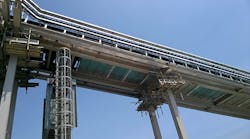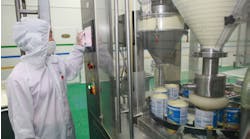Belt conveyors transfer many types of solids at chemical plants. A typical belt conveyor consists of many bits and pieces that should work together in harmony. The behavior of the belt and other parts are complex. So, unsurprisingly, operational and reliability concerns can arise.
The interactions with upstream and downstream units, e.g., a conveyor feeding it or equipment getting solids from it, are important, and can impact the operation and configuration of the conveyor(s).
The belt tension is a key operating parameter. Belt loading, thermal movement and dynamic tension waves (during starting, stopping, etc.) cause variations in belt tension. So, a take-up system is needed to control the belt tension. The configuration of the take-up system and related key parameters (minimum tension, belt sag, etc.) require great care.
This article provides practical guidelines and useful tips on the operation of belt conveyors and issues that might occur.
Belt Behavior
One of the key challenges in the operation of these conveyors is properly accounting for the complex behavior of the belt. It exhibits both elastic and viscoelastic characteristics when undergoing deformation. Basically, the belt shows time-dependent behavior under the influence of stresses.
Elasticity usually results from bond stretching along crystallographic planes in an ordered solid. In simple terms, the belt might become slightly loose under prolonged tension, although the take-up system and other tools may compensate for this. Viscoelasticity stems from the diffusion of atoms or molecules inside an amorphous material. Viscoelastic losses arise due to rubber-idler indentation. The resistances to motion are velocity dependent. The belt modulus changes due to belt sag between idlers.
The static behavior of belt conveyors has been known for decades. However, their dynamic behavior, e.g., during transients, starting and stopping, etc., isn’t as well defined. This closely relates to the elastic behavior of the belt and the conveyor’s structure and other key parts. Traditionally, design, part selection and operation neglected these elastic effects, although they are important for many conveyors such as long, large and high-speed ones. Old-fashioned simplistic static simulations have led to incorrect sizing of parts and components and mis-location of the take-up. Therefore, configuration and sizing of nearly all modern belt conveyors accurately account for dynamic behavior. It also should serve as a guide for operation, performance assessment and reliability improvement.
Transient conditions such as those during starting and stopping impose temporary tensions/forces on the belt. On one hand, this may result in extra tension compared to that during steady-state operation. On the other hand, some transient cases may lead to localized looseness/de-tensioning in the belt. These effects, particularly extra tension, may prompt early splice failure, excessive take-up travel and other operational difficulties.
Belt tension varies during operation. Both maximum and minimum tension are important. Maximum tension operation usually occurs at the discharge point on horizontal or inclined conveyors and at the loading point on regenerative declined conveyors. On compound conveyors, maximum tension operation frequently happens elsewhere. Knowing the maximum tension and its location is crucial for proper design, selection and operation.
Reliable operation requires maintaining a minimum tension in the belt using a take-up system. This minimum belt tension ensures transmission of the necessary drive power from the drive pulley onto the belt and restricts the belt sag to a certain limit. However, in practice, belt de-tensioning can occur unexpectedly during operation, particularly in belt conveyors with a geometrical profile that includes peaks, dips or valleys. An accurate dynamic study usually is needed to determine potential low-tension areas in the belt. It should focus on the dynamic nature of de-tensioning and the dynamic characteristics that contribute to the appearance of low tensions, for instance, in dips and other locations. For many belt conveyors with the drive at the head (discharge), the minimum belt tension on the carrying run usually will occur at the tail (feed) end.
Starting And Stopping
Starting is a stressful operational stage for any belt conveyor. Bringing a belt conveyor to operating speed involves high torque and tensions. As an indication, the starting torque of the driver (electric motor) may exceed 2.5 times the electric motor full-load rating. Such a torque transmitted to a conveyor belt could result in starting tensions many times greater than the normal operating tension. Preventing progressive weakening of belt (particularly splices of the belt) and subsequent failure requires limiting such starting maximum tensions. Different methods can reduce the starting tensions. One is the use of a variable speed drive (VSD) or another soft-start tool to decrease the high starting torque/tensions.
Stopping can occur two ways. Some belt conveyors just rely on removing the driver power to stop the belt. Many, though, have operational requirements that necessitate brake(s) for stopping. However, if the belt is brought to rest very rapidly, the inertia of the loaded belt may produce high tensions.
Determining the need for any braking action, other than the friction forces inherent in the belt conveyor system, requires consideration of several different stopping scenarios. For instance, the stopping can be intentional, emergency or the result of power failure. In addition, many different process and operational requirements could call for fast stopping.
The interactions with the upstream and downstream are important in stopping scenarios. A system consisting of two or more belt conveyors (one feeding onto another) ideally should have the drives interconnected electrically in such a way that stopping a conveyor for any reason also halts the one feeding onto it. This avoids a pile-up of bulk material on the second/subsequent conveyor that could cause hazardous situations or operational problems. In such a system, the length of the deceleration cycle of any successive conveyor should equal or exceed that of the preceding one. If it doesn’t, there are two options:
1. Apply a brake to those conveyors that coast too long. This is a straightforward solution and relatively easy one to accomplish.
2. Augment the stored energy of those conveyors that come to a stop too quickly, for instance, by installing a flywheel. Although a flywheel will lengthen the stopping distance of a belt conveyor, it also will increase its acceleration time.
In most cases, the application of a brake makes more sense, unless the braking would over-stress any member of the belt conveyor.
A problem occasionally reported for some belt conveyors is too low a belt tension during stopping. A few options exist to address this. Installation of a flywheel can extend the stopping time, which delays the decrease of the belt tension, and may allow the belt to stop before the tension reaches unacceptably low levels. If the stopping time is too long, use of a larger brake can increase the belt tension or decrease the stopping time. Alternatively, raising the take-up tension can boost the pre-tension of the belt. As an option, a brake in the take-up system can serve to heighten belt tension during stopping.
Take-Up Tension
To be suitable, a take-up tension must satisfy diverse requirements such as keeping the belt sag within limits, avoiding slip on the drive/brake pulleys, and preventing excessive travel of moving parts (for instance, the take-up carriage). Often, the running sag limit and stopping/starting sag limits set the required minimum tension in a belt conveyor. The take-up system should supply the targeted tension.
As indications, the running sag limit and transient (stopping/starting) sag limit could be 2% and 3% of the idler spacing, respectively. Excessive sags may lead to bulk material spillage or other operational problems. Special circumstances may call for lower sag limits that result in higher take-up tensions. For better operation of the belt conveyors, the running and stopping/starting sag limits might be specified as 1.5% and 2% of the idler spacing, respectively. On the other hand, certain conveyors may benefit from higher sag limits to reduce the take-up tensions, for instance, if belt lifting is experienced in a tight belt radii or similar situations.
Take-up systems fall into two general categories: automatic and fixed. The main types of automatic take-up systems are: gravity, winch and hydraulic. Fixed take-up systems usually are manual. However, there are hydraulic and winch take-up systems where the tension basically is fixed and only can be changed manually.
Gravity take-ups are most widely used. The take-up pulley in a gravity system is connected to a free-hanging counterweight. In a simple configuration of such systems, the tension at the take-up pulley equals half the counterweight mass. However, different configurations are possible. The gravity take-up controls the belt tension by allowing the take-up pulley to move up or down as conditions on the belt change. The belt tension at the take-up pulley doesn’t change except for variations caused by hysteresis (frictional losses in the sheaves or cable) in the take-up system and the counterweight inertia.
The take-up pulley in a manual fixed system is anchored to a fixed point. The displacement is constrained and the tension is variable. The fixed take-up does not control belt tension. However, it occasional requires manual adjustment when an upper or lower limit is breached. Once the take-up pulley has been adjusted, it does not move. Therefore, the tension varies as the load and temperature change. During starting or stopping, the fixed take-up can experience huge variations in tension due to the conveyor dynamics.
A primary disadvantage of a gravity system is that it typically is expensive, heavy and often bulky. A take-up tower and counterweight are needed. A downside of a fixed take-up is the need for adjustment (either manually or by other means) as the temperature or operating condition change. Thermal movement can be significant. Operating problems can arise if adjustment is not made.
Common Options
Low-indentation rubber belts are becoming popular. Such high-tech belts need less energy to overcome rolling resistance. However, the lower resistance might cause differences in the dynamic behavior of the belt conveyor. Nonetheless, starting requires the same amount of energy to accelerate the belt, the rolls and the bulk material. Therefore, as far as the starting is concerned, no changes may occur. If the belt conveyor drifts to rest, then the stopping time will increase, though. This may necessitate installing a brake to ensure the belt stops in an appropriate time frame (for an emergency stop or other cases).
The use of VSDs for belt conveyors remains a controversial topic. Many belt conveyors rely on VSDs because they offer great advantages for the start-up (soft start) and energy efficiency. In addition, VSDs provide operating flexibility — enabling many belt conveyors engineered for the maximum required capacity to operate normally at a relatively lower capacity when necessary for operational reasons. However, for some applications, variable-speed options incur costs and pose complexities that can outweigh their advantages.
AMIN ALMASI is a mechanical consultant based in Sydney, Australia. Email him at [email protected]



